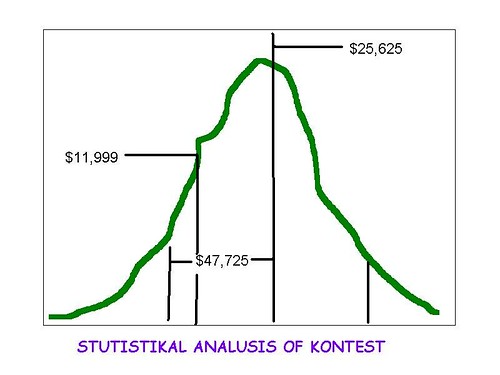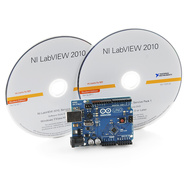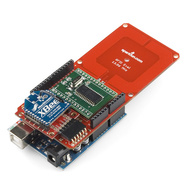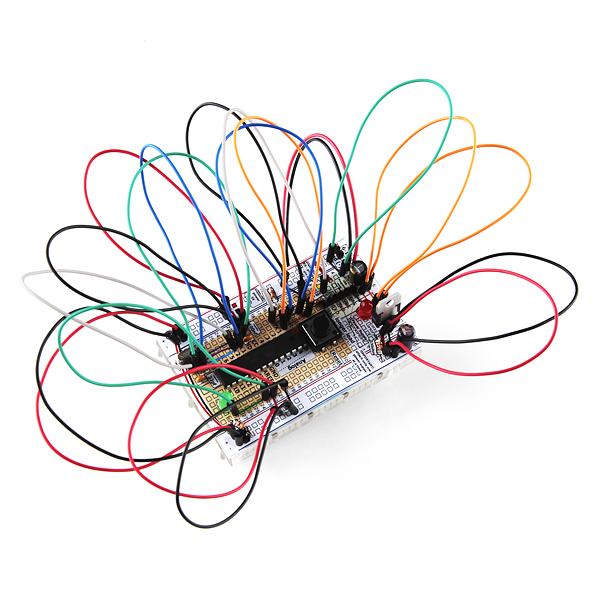This is a relatively uneventful week for new products. Not only did SparkFun have its summer party yesterday, but this time of the year, things tend to calm down a bit. Maybe it has something to do with the heat? So, we don't have a ton of new products, but there's still a few things which people should find interesting.
Looking through all the entries to the contest was quite interesting. There was a wide range of guesses from about $100 up to almost $500k! In the video, I promised to graph everything out, but my statistical abilities are a bit rusty and I forgot how to graph data into a bell curve (assuming it looks anything like one). So I did what anyone does when they've exhausted searching for an answer on Google - I opened MS Paint and faked it.
Nailed it!
In the end, the correct answer was $9,106, and our closest guess (without going over) was $9,100. Nice job! The average was $25,625, the median was $11,999, and the standard deviation was a whopping $47,725. This would have been one ugly (uglier?) graph if it had been real. In any event, thanks to everyone that entered and for all the overwhelming kind comments. We will do more contests in the future.
Love it or hate it, LabVIEW is a popular software. We are now bundling the student version of LabVIEW with an Arduino Uno. LabVIEW provides a graphical interface for your Arduino allowing a powerful toolkit for engineers, scientists, or even hobbyists.
We have a new version of our RFID Evaluation Shield. We've corrected the silk error from the last version. We've also added some example code which takes advantage of the data storage and retrieval features of the Mirare RFID tags. The example code lets you easily store and retrieve information from the 1K worth of storage on the Mifare 1K tags with simple commands. Check the video above (or the product page) for a demonstration.
Our new version of the 9DoF Razor now includes the new HMC5883L magnetometer. Otherwise, it's the same board we've been carrying. With the transition from the old magnetometer and the new gyro, this board is better than ever.
In addition to all the other new revisions, we also have a new minor revision of the Breadboard Arduino Compatible Parts Kit. This kit allows you to breadboard your very own Arduino. And with the add-on kit, you can solder it into a PCB. If you're looking to learn how to take a bare IC and convert it into a usable microcontroller, check out both of these kits. The new version of the kits uses the Arduino Optiboot Bootloader.
We now have our 1" metal standoffs back in stock. We are now selling these in packs of 10 and they are conveniently threaded for 4-40 screws on both ends.
Lately the new PICAXE microcontrollers have been showing up. This week we had the 20M2, which rounds out the new M2 family. PICAXE is a great beginner microcontroller and offers a lot of great features.
So that's all the products we have for this week. We'll be back with more stuff next week. In the meantime, stay cool (especially those of you on the east coast!) and I'll be back again soon with more new products.













I'm sorry, but I'm having a hard time taking you seriously with that moustache. I just can't look away!
It's Me a Mario!
1up!
it looks like a fake mustache I think it is epic
is it real?
Oh yeah, 100%!
I hope your not dipping your mustache in solder paste wax to curl the ends. You don't want lead poisoning. LOL.
I was wondering if you were planning to put on a train engineer cap and vistit the http://www.coloradorailroadmuseum.org and take a picture with the 317-ton Burlington locomotive #5629?
So what exactly was the contest? I'm in a work environment, so I never watch the videos.
Personally, I don't understand why Sparkfun stocks PICAXE products.
My personal view is that PICAXE is garbage, and an Arduino-based system can do anything you can do with PICAXE, a hundred times better and more user-friendly.
- Bootloader is proprietary closed software, you are locked into buying the pre-programmed PICs, and only the DIP ones are available.
- IDE is proprietary closed software, and it's Windows-only, so if you're not a Windows user you're not supported at all. There are no alternatives to using this IDE to program the devices; it's not based on a standard open compiler toolchain (like avr-gcc, in the case of Arduino).
- BASIC is a rubbish programming language, enough said.
- Requires development board or a breadboard plus the PICAXE chip plus the programming cable to get started, compared to an Arduino which you just plug into USB and it just works.
- The "official" programming cable requires an obsolete RS-232 port. However, I will admit that they have relatively recently resolved this by making USB cables available.
- Power is not supplied through the programming cable, meaning that batteries always need to be used, even when using the USB programming cable.
- There is nowhere even close to the same level of documentation and community support and openness and resources available compared to what you have with something like Arduino.
4) That's only a problem if you're making a one off. If you're making 500 of something, and you, you know, don't need a full Arduino board in there with all of that stuff you don't need once the thing leaves your workbench (like the ability to program it in circuit), then that's a spectacular thing. Which is also why they only sell DIP version. PICAXE was designed to be used in production environments, but be much easier to program for simple tasks than a raw AVR or PIC. Arduino was most certainly not.
5) You'd be amazed how many 'real world' programmers require RS-232. Heck, AVR's development board still uses it. And 9/10 industrial sensors do too. RS-232 is only obsolete in the consumer world. There's a lot to be said for the ability to just plug something in and send it serial commands with no extra hardware needed (beyond maybe a $0.10 MAX232 chip).
6) Again, this is a desirable thing in the intended use, which is in actual products.
7) True, but again different intentions.
1) That's not really a bad thing... I mean if you're messing with the bootloader, you might as well just program in native AVR on an STK500.
2) Again, for its use that's not really that big a deal. The Windows Only thing can be a problem (you're actually not completely correct, there are some backdoor hacks to do it on other IDE's, but they don't work as well), but honestly for the limitations of expressiveness of the language and processors, their IDE is more than sufficient. It also has a very excellent simulator and debugger.
3) Yes... and the thousands and thousands of BASICstamps sold every year, not to mention the fact that there are likely millions of scrips for Office written in basic, and basically every graphing calculator in existence implements some form of basic totally backs up that claim... :/ Is it as powerful as even a rudimentary high level language like C? No. Does it need to be to serve its purpose? Not at all.
At least one member of the PICAXE M2 family is still missing; the 08M2, which happens to be the one I want :/
Probably not going to happen, unfortunately.
Actually, I guess it will happen. I just checked. They're for sale on the Techsupplies.co.uk
Just so you're aware, there's a spelling error in the paragraph about the RFID Evaluation Shield (Mirare -> Mifare).
"...storage and retrieval features of the MiRare RFID tags..."
I thought Super Mario was a Plumber?
Has anyone ever tried using a Teensy board?
I know it's not meant to be a very accurate graph, but it'd be nowhere near as symmetrical as that - median of $11,99 but mean of $25,625. These two values are usually very close in a symmetrical, normally-distributed population. Just my 2c.
Adrian
Yeah, I know. But, at the same time, the standard deviation was $47k, which means the graph would be very very ugly.
The labview-nay-sayers should take a hike (or maybe a swim if you are experiencing this crazy heatwave) =P.
In industry R&D has a strong focus on "TIME TO DEVELOP". If you are designing hardware and want to verify a design, you probably don't want to be slowed down by the nitty gritty details in designing some sort of test harness. That's were Labview, Matlab (and maybe...HDL), as well as other similar languages come into play.
The same hold true to a "curious researcher". If you're interested in programming and want to learn more, then by all means go with C, heck learn assembly (cringes). But if your more interested in the hardware go with something simple and easy to manipulate so that your time is better spent working with the hardware.
I didn't get to see any of the products 'cause I was too busy looking at that truly epic moustache :D
I have a some what hard time buying that the molds only cost 9k... Maybe I missed something...
Eh, it was 2006, and it was China.
Well, all things considered, you guys got a pretty good deal. How many units were produced by the molds? Still in operation?
Hey, cool, my guess was pretty close!
I guessed $8000 - based mostly on some vague knowledge that model kit toolings cost somewhere in the tens of thousands of dollars, and the tooling for this thing was smaller than most kit toolings would be...
LabVIEW and the Arduino will go well with this:
http://www.apress.com/9781430238850
lab view..... ewwwww don't encourage that! my FRC robotics team uses that crap and its not teaching anyone anything about programming at all!
although it would encourage them to actually go out and build your own electronics insted of using the FRC crap to build everything...
That's because FRC has a very, very nice LabVIEW library that was developed for them that makes it seem like there's little actual 'programming' going on beyond hooking up wires.
Trust me, if you ever do any real programing in LabVIEW, from scratch, it's a LOT more intense, and powerful, than people give it credit for.
100% agreed using express VI's does not make you an expert in LabVIEW there is a lot more involved just like any other programming language out there.
Srry that was a bit hateful, I now speak with experience, and yes, it takes some effort. But no, you will not use it as a professional language in your career
http://code.google.com/apis/chart/interactive/docs/quick_start.html
google charts is a nice way to add charts to websites.
It's a bit different. The data doesn't have reference points, you're just graphing a histogram of the data.
You could use this.
This graph tickles my brain... in an inappropriate way.
Tell a big person where it touched you!
For some reason, that sentence reminds me of the word medulla oblongata.
Comic Saaaaaaaaaans!!
I did that just for all the people yesterday complaining about the font ;-)
AHHHHHHHHHHHHHH
its my brothers favorite fontttt!!!!!
I'm shocked that a tech company (even a hobby oriented one) couldn't figure out how to generate the most basic of graphs. :S
I know, right? What's funny is that I have a background in psychology, which actually uses a LOT of statistical analysis. I've conducted several experiments which needed relatively complex statistics, and I just couldn't figure this one out.
The caveat is that I didn't want to spend too much time on it as it's not my job to make graphs, so Paint was quicker and much cooler.
I can accept that explanation. :)
Background in psychology huh? I've got my MENG in EE and my father has a doctorate in psychology.
Ah, very cool!
when will the dso quad be back in stock?
Wow, I like how you wrote the name of the graph phonetically.
Eat Mor Chikin!
NICE! I love Chick-fil-A.
Some people just say NO to that.
You don't graph data on a bell curve in any special way. If you plot the data normally, with 'number of guesses' as the X and 'dollar value' as the Y, it should come out looking (more or less) like a bell curve with the gradient proportional to the standard deviation, and with the center of the bell on the average. Excel has a couple of tools for adding those markers to the plot though. In order to get any kind of meaningful shape though you'd absolutely have to make the range of your bins pretty large, as it's highly unlikely (given your standard deviation) that you got a lot of the same guesses.
On a more product-related note, any chance you'll be carrying the Arduino ADK/ADK-Mega board any time soon? It's out there in the wild, but I'd really prefer to get it from you guys. Got a shiny new Galaxy S2 coming in the mail today and it's dying for some micro-controller loving.
Yes, we're working on an ADK board. We usually don't like to talk about products before we're shipping them--SparkFun is not big on vaporware. But we let our friends at Google announce this one, so the information is already out.
Well, I mean I figured you'd just be carrying the Arduino version, like you do with the other boards, but it's cool if you're making your own version. Can't wait to put it to work.
To put it another way, the 'bell curve' is a phenomena that represents the shape that a graph of the number of samples in a population that have a given value (or range) typically takes, assuming a random/psudo-random sampling of the population.
The place many people encounter the Bell Curve is in professor's grading schemes for college courses. If a professor 'grades on the curve', they will plot out numeric grade vs. number of people that got said grade (which usually turns out looking a lot like a bell curve for your average college course), and then adjust the grading scale for their class so that the center of the bell represents the average letter grade they want their class to maintain (typically a C). They then travel left and right on the curve by a standard deviation per letter grade, et volla, you have a class who's grade distribution now follows a bell curve centered on your target average grade.
I think the key here is that Rob actually wanted to do a fake bell curve for comedic effect. Otherwise he would've gone and talked to IT's snazzy Data Analyst Randy, who provides us with tons of cool statistical analysis and of course reports as well. :)
Yeah, well all of you guys were at the baseball game while I was working on it :-)
Shhhh...
chuckles well I can see some people (actually a lot of people) that might genuinely be confused by that :p But yes, apparently this morning humor>me. I've been up since 5AM rowing :D
Anyway, any word on the official Arduino ADK boards?